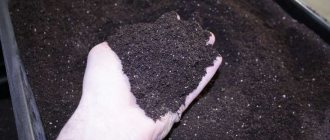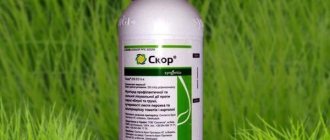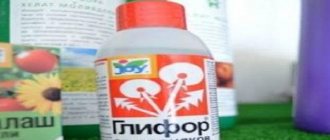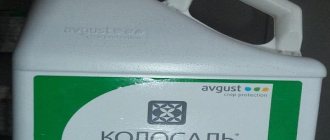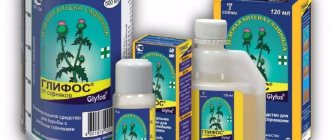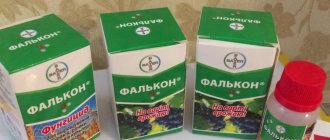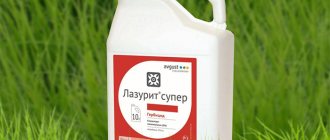Purpose and form of release
According to the instructions, a fungicide called Polyram from the manufacturer BASF is proposed to be used for the prevention of the following fungal diseases:
- rust;
- scab;
- septoria and alternaria;
- peronosporosis;
- late blight;
- mildew;
- anthracnose.
You can find the drug on the gardening market in the form of light brown small granules. Basically, the fungicide is packaged in large plastic packages of 1 and 5 kg, but you can also find small bags of the substance of 50 and 250 g.
Consumption rates
Cultivated plants require constant care and treatment with fungicides; when using Polyram, the standards are as follows:
| Plant | Polyram consumption |
| Potato | 40g per 10l |
| Tomatoes | 40g per 10l |
| Grape | 25g per 10l |
| Apple tree, pear tree | 20g per 10l |
Potato
Fungal diseases sometimes affect potatoes so severely that losses amount to about 60% of the entire crop. Potatoes are processed in 4 stages:
- tops closing;
- the appearance of buds;
- end of flowering;
- formation of berries.
About 50 ml of the total solution is consumed per 1 m2.
Tomatoes
Plants that are already infected with the disease are almost impossible to cure. Therefore, prevention is given as much attention as possible until the process becomes irreversible. The mixture is diluted in the required proportions and the plants are treated with it. Spray tomato bushes 3 times every 20 days. Usually about 40-60 ml of the drug is used per 1 m2.
Grape
For this crop, it is also especially important to carry out preventive spraying. In total, it is necessary to process the vineyard 4 times before harvesting:
- inflorescence formation;
- completion of flowering;
- appearance of berries;
- half a centimeter berry.
For 1 m2 of vineyard, 90-100 ml of dissolved Polyram is required.
Apple, pear and other fruit trees
Garden crops are sprayed in 4 stages throughout the growing season:
- appearance of leaves;
- formation of buds;
- completion of flowering;
- fruit size 40 mm.
About 4-7 liters of mixture are consumed per tree.
Composition and mechanism of action
The main active ingredient of the fungicide Poliram is metiram - in the instructions it occupies about 70% of the total volume of the drug. Methiram is a dithiocarbamate, and its effect is that the substance interferes with the synthesis of vital enzymes in pathogenic organisms and thereby blocks their development. Fungi do not develop tolerance to metiram, so Poliram is suitable for regular use.
Important! The fungicide is intended for preventive treatment of vegetable and fruit plantings strictly according to the instructions. It is not recommended to treat tomatoes, potatoes and other crops with its help.
Description and scope of application of Polyram
The fungicide Poliram (Poliram DF from Basf) belongs to the contact action preparations of the preventive group. That is, its granules must be diluted on a water basis and used only to prevent a number of diseases:
- Alternaria and late blight (brown rot) - potatoes, tomatoes;
- mildew (downy mildew), anthracnose (bitter rot) - grapes;
- scab, rust - pear, apple tree;
- peronosporosis (downy mildew) - onions.
As can be seen from the list, this drug is used to treat both fruit trees and vineyards and cultivated plants. The fairly wide versatility of the drug is determined by the use of metiram, a dithiocarbamate, which prevents the synthesis of enzymes in fungi.
The advantage of metiram is that diseases do not have resistance to it, and this increases its effectiveness. Another advantage is the use of an aqueous solution, which prevents accidental inhalation. It is low toxic compared to other fungicides. It is safe against plants, insects, and bees (during processing, they must be isolated for a day or more).
However, it is worth noting a number of disadvantages. These include toxicity to animals and humans. You should work with the drug only in a change of clothes with a respirator. After use, thoroughly wash all equipment; the gardener himself needs to take a shower. This is aggravated by the fact that the drug acts for a short time, therefore, spraying is carried out abundantly. Polishers are diluted immediately before use, and long-term storage of the ready-to-use solution is not allowed. The disadvantage, but also the advantage, of Polyram is the ability to quickly wash it off from the treated surface.
Advantages and disadvantages
The fungicidal agent has its strengths and weaknesses. Among the advantages of Polyram the following can be noted:
- the fungicide is very effective when used against most fungal diseases, and over time, microorganisms do not develop resistance to the action of the drug;
- the use of Polyram according to the instructions is recommended for many vegetable and garden crops; it can be sprayed on potatoes and tomatoes, cucumbers and onions, and fruit trees;
- Polyram does not have a negative effect on cultivated plants and is approved for use during the period of bud setting and flowering;
- The fungicide easily dissolves in water, it is very simple to prepare it according to the instructions, and during use the product does not disperse into the air.
However, the fungicide also has disadvantages. Namely:
- Quite a large consumption of the drug when used over large areas;
- toxicity to humans and domestic animals;
- instability to the effects of precipitation; in damp, rainy weather in the open air, the drug may stop working prematurely.
Also, the drug does not retain its beneficial properties for long after preparation; spraying should be done immediately after mixing the solution; the next day the fungicide will become useless.
Security measures
Fungicide Poliram belongs to hazard class 2. It is harmful to humans, but has no toxic effect on plants. The drug settles on the surface of the plant tissue and is washed off with water. Avoid getting the substance into bodies of water.
When working with Poliram, you must adhere to the following rules:
- you should use gloves, special clothing, a respirator and goggles;
- do not smoke, drink or eat while working;
- after completing the procedure, wash your hands with soap, go to the shower and put on clean clothes;
- open packaging must be tightly closed and put into a bag;
- Do not prepare the solution in food containers.
Polyram can be stored for no more than 24 months.
Important! To prevent the fungicide from losing its properties, it must be protected from moisture, direct sunlight and heat.
How to properly prepare a working solution
According to the instructions, dry granules of the drug Poliram must be diluted in a large amount of water. The standard proportion is 40 g of substance per 10 liters of liquid, however, depending on the specific crop, the dosage may vary. When preparing, the substance is first poured into 5 liters of water, stirred thoroughly, and after that the remaining water is added in portions, without stopping stirring the solution.
The final mixture should be completely homogeneous, without any remaining undissolved granules. During spraying, the solution is also stirred from time to time so that sediment does not accumulate at the bottom.
Attention! When stored in finished form, polish quickly loses its valuable properties. Therefore, the instructions recommend treating the plantings within 6-8 hours after mixing the solution.
Storage
Since this product is toxic to humans and warm-blooded animals, it should be kept out of the reach of children and pets, away from food, pet food and medicines.
The room should be with low humidity and a temperature of up to 20 degrees Celsius. Also, this drug should not be exposed to sunlight.
Shelf life of Polyram: 2 years if the rules are followed.
Instructions for use of the drug Polyram
The procedure for using Polyram depends on which crop needs to be protected from fungal diseases. According to the instructions, dosages and number of treatments per season may vary.
For potatoes
Fungicide Poliram helps protect potatoes from Alternaria blight, late blight and other ailments. Plantings need to be sprayed four times a season, at the very beginning of the growing season, then before flowering, after flowering and during the period of crop formation.
The use of Polyram solution for potatoes is standard - 40 g of dry granules are diluted in a bucket of water according to the instructions and sprayed evenly on the plants, trying to treat each bush entirely.
For tomatoes
Tomato plantings are also often affected by late blight and alternaria. Since it is very difficult to treat already infected plants, it is easier to prevent diseases; this can be done by using Polyram according to the instructions.
Tomatoes are sprayed with a solution of standard concentration - 40 g of substance per bucket of water. Treatment should be carried out 3 times per season, the interval between spraying should be 20 days.
For the bow
According to the instructions, spraying with Polyram helps protect onion plantings from fungal diseases. The seedlings are treated with a standard solution of 40 g per 10 liters of water three times per season, first during the growing season in the spring, and then 2 more times with an interval of 20 days.
For grapes
Grapevines are often affected by mildew and anthracnose. The use of Polyram helps prevent the appearance of fungus, but according to the instructions, it is diluted in a slightly smaller proportion.
Instructions for using the fungicide Poliram on grapes state that only 25 g of dry granules need to be dissolved in 10 liters of water. Mix the solution in the same way as usual: first in a small amount of water, and then fill the bucket to the top. You need to spray grapes 4 times during the warm season: during the setting of inflorescences, immediately after flowering, then during the formation of the harvest, and the last time after the berries have grown a little. The intervals between treatments should be 20 days, this is how long the protective effect of the fungicide lasts.
For fruit trees
The use of Polyram allows you to protect fruit trees in the garden from rust, septoria and scab. Pears and apple trees are sprayed with a solution of low concentration - 20 g of dry granules are diluted per 10 liters of water.
The treatment according to the instructions should be carried out 4 times: first during the blossoming of the leaves, then during the budding period, and then after flowering and after the fruits appear, when they reach about 5 cm in diameter. The Poliram fungicide continues to protect trees for about 40 days after treatment, and Spraying an individual tree requires about 5 liters of solution.
Reviews from those who have used Polyram
Elena, 36 years old, Yekaterinburg For several years I had to fight anthracnose in my vineyard. Therefore, next spring I decided to carry out preventive spraying of the grapevines. To do this, I used a solution of the fungicide Polyram. I diluted the product according to the instructions and applied it, but in the summer anthracnose reappeared. Either I diluted the product incorrectly, or the drug was expired, but I had to purchase another fungicide to save the vineyard from this fungal disease.
Olga, 40 years old, Ivanovo region I used the drug Polyram to protect apple and pear trees in the garden from fungal diseases. However, I didn’t like that the treatments had to be carried out several times a season to completely protect the fruit trees. But as a result, my trees were not affected by scab and other fungal diseases. Therefore, I will now use this product annually.
It should be noted that this fungicide can only be used for preventive treatments against fungal diseases on garden and vegetable crops: that is, in advance, and not only during the period of the onset of the disease. Moreover, the product is quite effective and after treatment protects plants for 3 weeks.
Recently also searched:
Precautionary measures
Despite the fact that the use of the fungicide Polyram is safe for cultivated plants, the drug poses a certain danger to humans. Therefore, when spraying according to the instructions, you need to follow simple safety rules.
Namely:
- use safety glasses, gloves and a respirator;
- carry out spraying in thick clothing that protects not only the body, but also the hands;
- do not allow the solution to come into contact with the eyes, skin or mucous membranes;
- do not eat or drink during treatment;
- Wash with soap and change clothes after finishing spraying, and put your work clothes in the wash.
Advice! An opened bag of Polyram granules must be tightly closed after preparing the solution and stored in a place inaccessible to children and animals.
If there is excess solution left after processing the plants, it should absolutely not be poured into water bodies.
Compatibility with other drugs
Experts are wary of using Polyram and other products - fungicides, insecticides - in one mixture. It is strictly forbidden to combine with any product that has an acidic reaction.
Before mixing two or more drugs together in one container, a small number of components are checked for compatibility. If they have dissolved without sediment, flakes, or liquid separation, then a combination of fungicides and pest control agents is suitable for treatment.
Polishers are combined with other plant treatment products, for example:
- Strobe;
- Fastak;
- Acrobat.
Analogues of the fungicide Poliram
Although the fungicide Poliram is very popular, sometimes it may not be available for sale. In order not to miss deadlines and not to postpone spring spraying of plants, you can use analogues that are similar in composition and effect:
- Copper oxychloride - the drug helps well against the same diseases as Polyram. It is also used only for prevention; copper oxychloride is not suitable for treating plums and cherries in the garden, but it is not toxic to humans.
- Polycarbacin - this drug can be used to prevent fungus in vegetables, grapes and fruit trees. Despite its high efficiency, the product does not harm animals, bees or human health.
- Mancozeb is a product suitable for processing grapes, tomatoes and potatoes, it acts quickly and reliably, and does not harm the cultivated plants themselves.
The procedure for preparing and using solutions may differ; in each case, the instructions for use for a specific drug should be looked at on the packaging.
Safety rules when working with the product
Before processing, you should wear a protective suit, hat, gloves and goggles. After spraying, be sure to take a shower and wash your hair thoroughly.
Also, during the procedure, animals should not be allowed nearby.
When spraying the plant, it is better to choose windless days so that during the procedure the liquid does not splash in all directions and does not fall on a person.
See also
Instructions for use of the fungicide But, composition and release form of the productRead
Advantages and disadvantages
"Polyram" has clear advantages when used rationally and a number of limitations.
Advantages and disadvantages
active preventive action; rapid onset of effect; maintaining fungicidal activity for up to 3 weeks; exclusion of the formation of resistance in fungal agents; lack of phytotoxic properties; low risk to pollinating insects; convenient to dispense and use granular form.
limiting use to prophylactic purposes; the need for repeated treatments; high degree of toxicity to humans.
The lack of a systemic effect deprives “Poliram” of resistance to adverse weather conditions, which must be taken into account when planning work.
How does the product work?
The mechanism of the antifungal action of the fungicide is due to the effects of the compounds included in the active composition.
Tebuconazole is a representative of the third generation of the triazole class. It is distinguished by its rapid rate of penetration into the plant’s conducting system, providing a therapeutic and prophylactic, eradicating effect on fungal cells. The substance inhibits the synthesis of ergosterol and disrupts metabolic processes in pathogen cells. Pronounced activity was noted against various types of rusts of grain crops.
Prothioconazole also belongs to a number of triazoles, but differs in the speed and spectrum of antifungal effects. The compound blocks the biosynthesis of ergosterol and prevents the growth and reproduction of fungal cells. A pronounced therapeutic effect is observed against pathogens of powdery mildew, spots, and rusts. The peak therapeutic concentration is not reached as quickly as in the case of tebuconazole, but persists for a long time.



